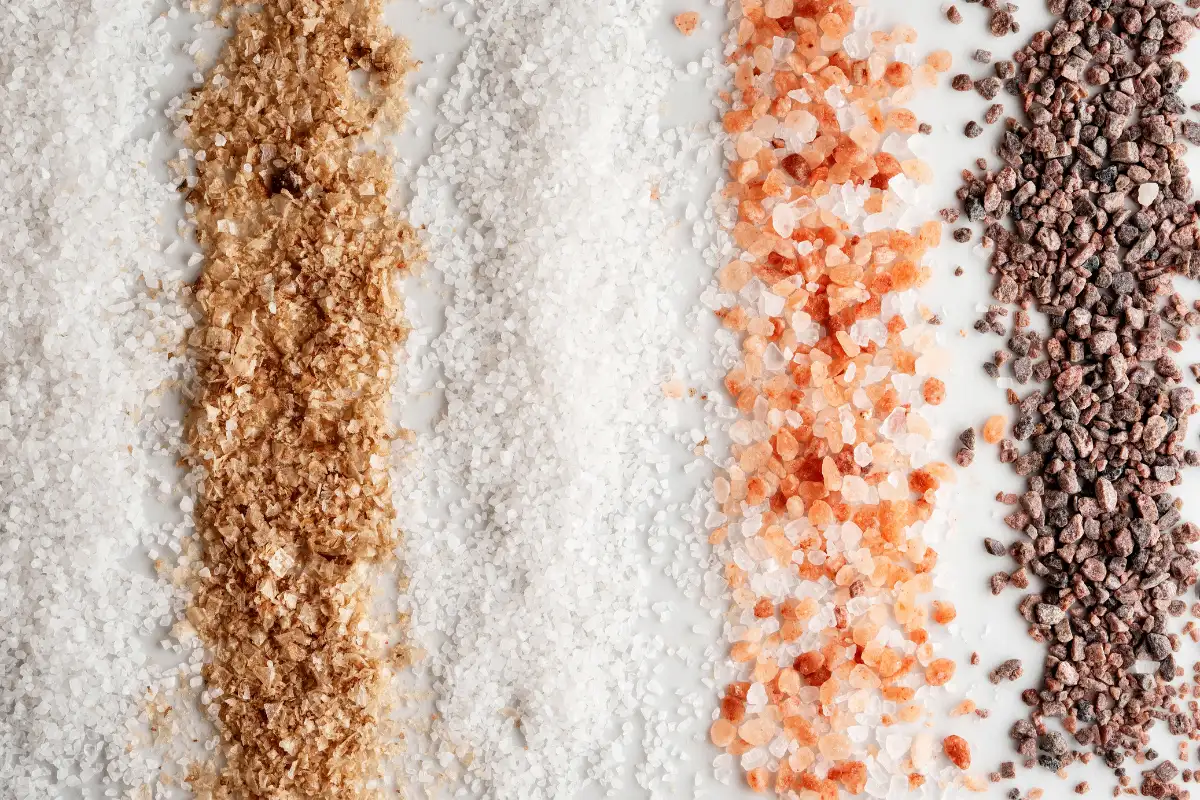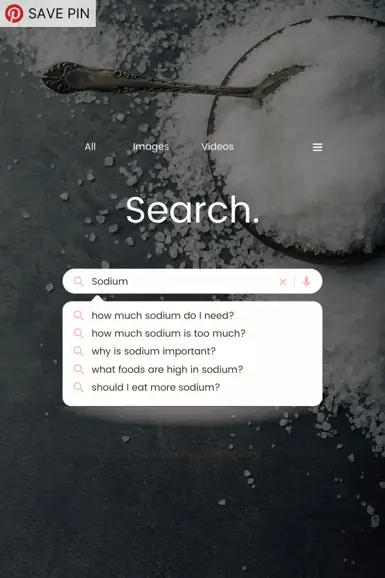
How much sodium do you need per day? Is sodium good for you? Today, we’re breaking down one of the most controversial, misunderstood minerals.
When you hear “sodium,” you probably immediately think of salt. While sodium is a part of what makes up salt, it’s more than just a tasty flavor enhancer.
Sodium is important in maintaining your overall health and well-being, from keeping you hydrated to helping your nerves and muscles work properly. Let’s walk through where sodium comes from in your diet, how it supports your body, how much sodium you need, how to manage intake for optimal health, and the potential effects of sodium imbalance.

What is Sodium
Sodium is a natural mineral found in most foods you consume. When you add chloride to sodium, it becomes sodium chloride, or what we know as table salt. You might sprinkle this on top of your food for a little extra flavor.
Advertisement
Sodium is an essential mineral your body needs. It’s one of several electrolytes that support your body’s functions and internal balance. It does a lot of work for your body, like helping to regulate blood pressure, maintaining optimal fluid balance, and supporting nerve function and muscle contractions.
What Foods are High in Sodium?
Because sodium is a naturally occurring mineral – think of all the fresh saltwater on earth – it’s in virtually all food and beverages you consume. The amount of sodium in fresh fruits, vegetables, and minimally processed foods is generally low. But if you’re monitoring intake, it’s important to remember that everything contains at least some sodium.
The most common source of sodium in the diet is from processed foods. Sodium is often used as an additive in processed and packaged foods to help preserve them, extend shelf life, and make them tastier.
Most convenience foods, like frozen meals and snack foods, are significantly high in sodium. You’ll also find high amounts of sodium in canned soups and broths, processed meats like bacon and sausage, packaged snacks, and store-bought sauces and condiments.
Advertisement
How Much Sodium Per Day to Lose Weight?
So, how much sodium do you actually need?
The American Heart Association (AHA) recommends no more than 2,300 mg of sodium daily for the average adult to maintain good heart health. The AHA also suggests consuming even less—closer to 1,500 mg per day. But there are things to consider for your sodium intake, including age, race, sex, current health conditions, health risks, activity level, and hydration.
Consuming a lot of sodium can make you retain water more easily. So reducing sodium in your diet may help you lose water weight, along with bloat, as is a common trait of water retention. Excessive sodium also pulls water into the bloodstream and leads to high blood pressure, which can eventually lead to more serious illnesses like heart disease.
However, sodium is an essential mineral, and your body needs it. Not having enough sodium in your diet can lead to electrolyte imbalances and issues like muscle cramps, fatigue, or poor nerve health. Finding the right sodium balance for your body is crucial for health and weight management.
Advertisement
Figuring out how much sodium is right for you depends on your unique factors, like your lifestyle, training frequency, and health goals. Talk to your doctor or chat with a WAG nutrition coach for more personalized guidance in developing a nutrition plan that works for you.
Have you ever watched a player fall to the ground with leg cramps during a sporting event? Intense exercise or activity causes you to lose sodium—and other electrolytes like potassium, magnesium, and calcium—through sweat. Sodium helps control muscle contractions, making you more susceptible to muscle cramps when you don’t get enough sodium.
Aside from this, sodium does many great things for your body like:
- Balancing fluid levels
- Keeping you hydrated
- Regulating blood pressure
- Supports proper nerve function, ensuring communication signals move throughout the body efficiently
- Supporting digestion—you need sodium for good stomach acid, which helps break down food and absorb nutrients
Health Implications of Sodium Imbalance
Sodium balance is important. Negative health impacts can result from too much or too little in your diet. High sodium intake is strongly linked to high blood pressure, which is a major risk factor for heart disease, stroke, and kidney disease. But low levels in your body also pose a risk. In the case of hyponatremia, where sodium levels in the blood are too low, you may experience fatigue, confusion, and muscle weakness/cramps. In serious cases, this can lead to seizures or coma.
Sodium imbalance, high or low, can greatly impact cardiovascular health because it disrupts fluid balance and electrolyte levels in your body. This can be problematic and lead to issues like compromised blood circulation, irregular heart rate (arrhythmia), swelling, or edema.
Advertisement
How to Manage Your Sodium Intake
Taking control of your sodium intake may seem overwhelming, but it’s absolutely possible. Just a mix of mindfulness with a little research, planning, and practice. Here are four quick tips.
1. Log Your Food
The first step is to get familiar with the foods you eat regularly and begin to make informed decisions. Start reading nutrition labels on your staple items and calculate the amount of sodium you’re consuming on a regular basis. From there, logging your food in an app can help. Don’t forget the add-on items, like cheeses, sauces and condiments.
A food-tracking app like MacrosFirst or MyFitnessPal is a great way to monitor your sodium levels. At WAG, our coaching portal allows you to sync your MacrosFirst or MFP logs so your coach can also see what you’re eating and help you monitor your overall intake—including sodium levels.
2. Pay Attention to Serving Sizes
Pay attention to serving sizes. We’ve all been there: eating spoonfuls of peanut butter straight from the jar. But contrary to what we wish, the serving size is not half the jar. Servings add up quickly, so be mindful of how much goes into your body.
Advertisement
3. Opt for Fresh and Frozen
Fresh fruits and veggies (or, frozen fruits and veggies without added seasoning or sauces) are naturally very low in sodium. Canned fruits, veggies, soups, and other more processed options tend to have added sodium that adds up quickly.
4. Get Creative in Your Kitchen
Being creative in your own kitchen puts you in the driver’s seat. Use aromatics—fresh herbs and spices—when cooking your favorite dishes. Add in flavor from citrus fruit or vinegar to enhance the taste of your food. And play around with different cooking techniques like steaming, grilling, roasting and sauteing. Each one can increase natural flavor in its own way without adding too much salt.
Conversely, if you’re eating mostly whole foods and heavily limiting processed foods, salting your food can help you increase your intake and get enough sodium throughout your day.
Tips for Eating Out While Managing Sodium Intake
If you think managing sodium intake while going out is too challenging, we’ve got you covered. Here are a few things to keep in mind when you go out to eat:
Advertisement
- Research in advance and choose simple and fresh. Identify lower sodium options before you step foot in the restaurant, and opt for dishes with fresh, whole ingredients prepared through simple cooking methods, like grilling, steaming, or roasting.
- Modify as you wish. Don’t be afraid to ask servers for special requests, such as asking to omit cheese or bacon in a salad.
- Be saucy on the side. Ask for condiments, sauces, and dressings on the side to control how much you use.
- Pay attention to portions. Restaurant portions tend to be large, so consider sharing an entrée or boxing up some of it as soon as it arrives at your table.
- Stay hydrated. Flush out excess sodium with plenty of water to wash down your meal.
Debunking Common Myths About Sodium
Let’s bust some myths about sodium that may be holding you back from optimal health.
Myth: All sodium is bad for you.
Sodium often gets a bad rap because of the link between salt and heart disease. But remember, sodium isn’t inherently bad for you! Your body needs it for optimal function, and moderating intake while getting sodium from quality sources like whole, nutrient-dense foods and minimizing intake from processed foods is key.
Myth: Only salty foods contain sodium.
Yes, processed snacks like chips and pretzels are salty and often high in sodium. But you’ll find sodium in most foods, even the ones that don’t taste salty, like sweet breakfast cereals or juices. That’s why it’s important to read nutrition labels and stay aware of what’s in your foods.
Myth: Salt causes high blood pressure in everyone.
While excessive salt intake can contribute to high blood pressure in some people, it won’t be the case for everyone. Individuals respond differently to sodium. Factors like genetics, lifestyle, and overall diet also contribute to how sodium impacts your body.
Advertisement
Final Thoughts on How Much Sodium You Need
Knowing how sodium impacts the body through optimal hydration, muscle health, and nerve function while addressing misconceptions about sodium and health is important for making informed decisions.
You are unique, and your response to how much sodium you consume will also be unique. Understanding your daily sodium intake is the first step in knowing how to make adjustments.
You can better control your sodium intake by reading nutrition labels, opting for fresh and frozen foods, and being adequately prepared to enjoy a meal out with friends or family. The key is focusing on a balanced diet while being mindful to enjoy the benefits of sodium in your body and increase overall health and well-being.
If you need help monitoring your sodium intake and adjusting your food choices, WAG Nutrition Coaching can help. Your 1-on-1 coaches can look directly at your food logs to give suggestions, keep tabs on nutrient intake, and help you determine what and when your food choices need to change.
Advertisement
References:
- American Heart Association. (2024). How Much Sodium Should I Eat Per Day. Retrieved from https://www.heart.org/en/healthy-living/healthy-eating/eat-smart/sodium/how-much-sodium-should-i-eat-per-day.
- American Heart Association. (2021). Get the Scoop on Sodium and Salt. Retrieved from https://www.heart.org/en/healthy-living/healthy-eating/eat-smart/sodium/sodium-and-salt.
- U.S. Food & Drug Administration. (2021). Sodium In Your Diet. Retrieved from: https://www.fda.gov/food/nutrition-education-resources-materials/sodium-your-diet.
- Nutrients. (2023.) Sodium Homeostasis. Retrieved from: https://www.ncbi.nlm.nih.gov/pmc/articles/PMC9862583/
- Healthfully. (2011). Sodium Choloride and Digestion. Retrieved from: https://healthfully.com/sodium-chloride-and-digestion-7445140.html
- Nutrients. (2019). Sodium Intake and Hypertension. Retrieved from: https://www.ncbi.nlm.nih.gov/pmc/articles/PMC6770596/
- Cleveland Clinic. Hyponatremia. Retrieved from: https://my.clevelandclinic.org/health/diseases/17762-hyponatremia
- Cleveland Clinic. Edema. Retrieved from: https://my.clevelandclinic.org/health/diseases/12564-edema
Amy Cimo
Amy is a Nutritional Therapy Practitioner and Certified Personal Trainer based in Baton Rouge, Louisiana. She is enthusiastic about helping others find a balance between nutrition, movement, and mindset to live happy and healthy. Amy has a BA in Mass Communication, a BS in Marketing, and a passion for storytelling and connecting people with relevant information and resources.
Get a WAG Coach
Working Against Gravity has led the macro tracking and health space for over a decade. Our team doesn’t just understand the science of nutrition—we’ve spent years mastering the art of tailoring it to fit your life. That means no cookie-cutter plans, just real strategies that have worked for over 30,000 people.
Choose from our membership options and start working with an expert 1-on-1 coach today.



